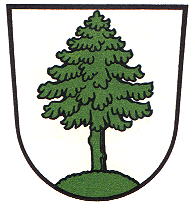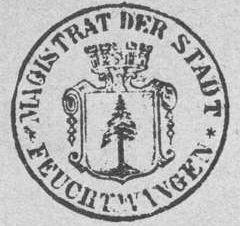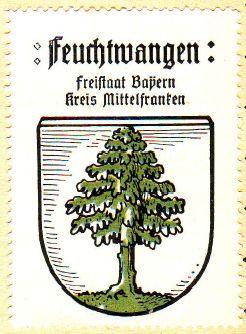Feuchtwangen
FEUCHTWANGEN
State : Bayern
District (Kreis) : Ansbach (until 1973 Feuchtwangen)
Additions: 1972 Aichau, Aichenzell, Banzenweiler, Breitenau, Dorfgütingen, Heilbronn, Krapfenau, Larrieden, Mosbach, Vorderbreitenthann
| German | In Silber auf grünem Boden eine grüne Fichte. |
| English | blazon wanted |
Origin/meaning
Feuchtwangen was until 1376 a possession of the Emperor of the Holy Roman Empire. In 1376 it became a possession of the Margraves of Nürnberg. Until 1819 the city used two different symbols on its seals and arms; the imperial eagle and a canting pine tree (Fichte=pine tree). The eagle was the symbol most used on the seals of the city, whereas the tree was more often used in less official documents. In 1819, when the city belonged to Bayern, the Bavarian government ordered the removal of all old imperial symbols. Ever since only the tree is used as the arms and symbol of the city.
The use of the pine tree itself is considered an historical mistake. Some centuries ago the people of Feuchtwangen could not decide where the name of the city came from. The old name was Fiuchtingwanc and so they discussed if the name came from "fiotha" (old German for pine tree) or from "feuchte Aue" (damp meadow; "wangen" means "Aue") - they decided for the pine tree what was wrong.
Today it is known that there have never been pine trees in Feuchtwangen as the ground is too loamy.
| The municipal stamp shown in 1892 |
The arms by Hupp in the Kaffee Hag albums +/- 1925 |
This page is part of the German heraldry portal |
Heraldry of the World |
|
German heraldry:
|
Selected collector's items from Germany:
|
Contact and Support
Partners:
Your logo here ?
Contact us
© since 1995, Heraldry of the World, Ralf Hartemink 
Index of the site
Literature: Stadler, 1964-1971, 8 volumes; lower part by Andreas Fohrer, Feuchtwangen














